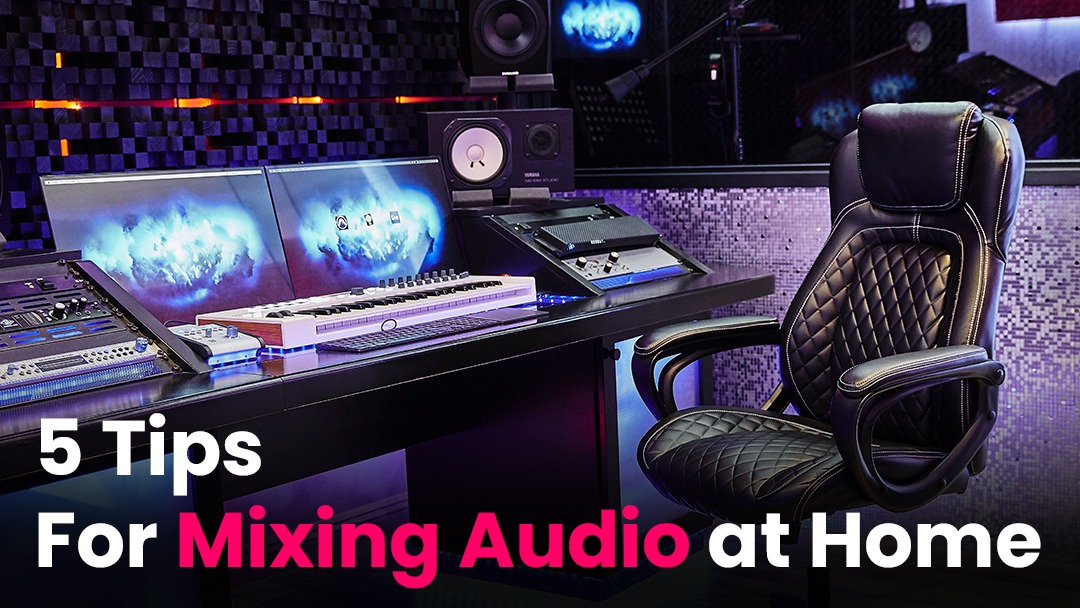5 Tips for Mixing Audio at Home

5 Tips for Mixing Audio at Home
Typically, when one thinks of audio and music mixing, most people envision enormous studio consoles that are 12 feet long and have so many knobs and faders that they can't even count. These tools are still used in high-end professional music studios, but it's much more likely that you'll be clicking and dragging on digital faders in software like Pro Tools, Logic, Steinberg Cubase, or Garage band if you're mixing in a home studio. In the end, you're essentially performing the same tasks as a qualified mix engineer.
ZOOM Recording Studio, an excellent place for mastering sounds and music, gives you five important tips for mixing audio at your home studio.
What is the meaning of audio mixing?
Generally speaking, the process of balancing and editing recorded audio tracks to create a good blend of all the sounds on a single song is audio mixing. If you've reached the music mixing stage, you've probably already tracked your instruments, whether vocals, brass, strings, drums, guitar, or bass. Perhaps you've also used software synthesizers that are controlled by MIDI to produce audio tracks. Regardless of the instruments, you're using tracking comes before mixing.
While you will be doing these mixing:
· Ensuring that all instruments can be heard at the desired volume by balancing the audio levels. The use of compression plugins can help you.
· Filling the sonic palette with a variety of frequencies to make it sound appropriately rich. The use of EQ effects and plugins can improve this.
· Adding reverb, modulation, and distortion/overdrive to bare audio tracks.
· Correcting errors made during instrumental trackings, such as using Auto-Tune or de-essing on vocals or filters and EQ to reduce guitar string squeaking.
The 5 important tips for mixing audio at a home studio
Trial and error are a big part of audio mixing. Simply put, you will learn more and achieve better results the more mixes you perform. In light of that, here is some advice to help home producers avoid many of the common problems they face.
Pan your instruments subtly - Some novice mixers make the error of placing all of their instruments in the stereo mix's "center." The listener can better distinguish each instrument by using subtle panning to move some instruments to the left or right of a sound stage.
Add compression moderately - A compression is a fantastic tool for giving your music depth and for making your mixes fill the space. Overusing this effect, however, can deaden a mix. Keep in mind that compression works by muting your loudest signal and then if desired, amplifying the volume of everything else. As a result, your loud sounds become quieter and your quiet sounds louder.
Reverb but wisely - With today's digital technology, it's typically best to record a vocal or instrument very dryly and without any reverb before adding it later in the mixing process. Creating the appearance of a stunning, spacious recording studio or concert hall when you were actually recording in a clothes closet can be a magical effect. However, a little reverb can go a long way, much like compression. Vocals in particular bear this out. Don't drown your singer's lyrics in a sea of murky reverb if she wants to communicate something through them. Add just enough to give the scene some atmosphere, but not too much that you lose focus and clarity.
Use a high-pass filter but in moderation - In headphones, too much bass may sound cool, but it can muddy up a mix and make it difficult to hear individual parts. Clarity can be added to your mix by subtly using a high-pass filter, which blocks some low frequencies while allowing higher ones to pass through. There is typically a high-pass filter option built into EQ effects and plugins.
Test the mix on several sets of speakers - It's great if you're mixing with top-notch headphones or studio monitors because you can add nuance and detail to the mix. Many of your listeners might not be playing back the track on such nice equipment, which is the problem. Be realistic about how the majority of your audience will experience this music. Will laptop speakers be effective? A radio in a car? earbuds? TV sound bar? Make sure you're hearing your mix on the platform where it will probably be heard.
Conclusion
Thus, with these tips, you can better your composition. Every artist must know these to enhance the quality of their creations and make an impact on the listeners. However, if you feel the need of getting your work done professionally, ZOOM Recording Studio is there to help you. We offer several music-related services such as providing studio rental, mixing and mastering the music, and more.
To know more about our services, connect with us.